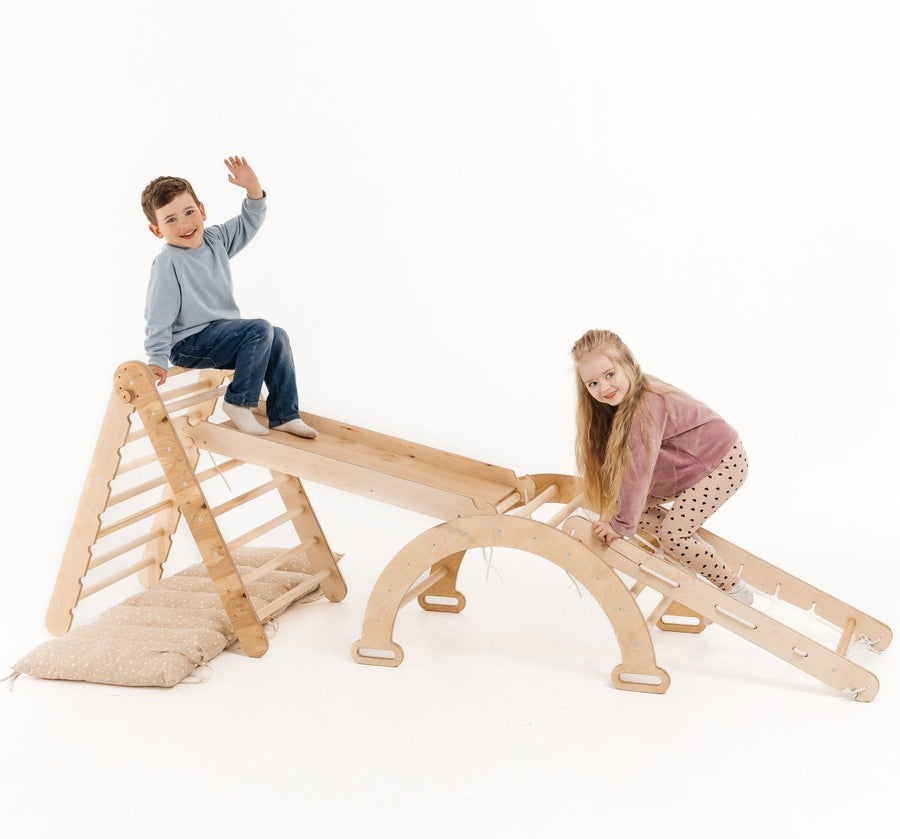How to Choose the Perfect Montessori Toy for Your Child?
Nurturing Development Through Montessori Toys
In this comprehensive guide, we'll explore the various facets involved in choosing the ideal Montessori toy for your child. We'll delve into how your child's unique interests and developmental stages intertwine with the principles of Montessori education to guide your choice. We hope this guide will serve as a useful compass, helping you navigate the sea of options and finding that perfect Montessori toy that can light up your child's learning pathway.
Unfolding the Montessori Philosophy
Essentially, the Montessori teaching philosophy revolves around two primary principles: respect for the child and their individuality, and belief in the child's inherent potential. "The child is both a hope and a promise for mankind," Montessori asserted, encapsulating the essence of her vision. Understanding the philosophy behind these educational toys will help you appreciate their design and purpose, guiding you to make the best choice for your child.

Source: Wikipedia.com
Children are Active Learners
A foundational concept of the Montessori Method is the idea of children as active learners. Rather than being passive recipients of knowledge, children are seen as eager explorers of their environment. Montessori toys cater to this intrinsic curiosity, creating opportunities for children to engage with the world around them in a purposeful way.
Independence and Freedom Within Limits
Freedom within limits is another key principle. This concept acknowledges the child's desire for autonomy while providing a safe, structured environment for exploration. Toys designed with this principle in mind empower children to learn independently, enhancing their problem-solving skills and fostering self-confidence.
The Prepared Environment
The Montessori Method advocates for a "prepared environment" – a learning space that is thoughtfully organised, aesthetically pleasing, and developmentally appropriate. The Lego sorter, for instance, helps to create an organised environment, resulting in order not only on the playroom floor but also in your little one’s mind. Aiding in fine motor development, hand-eye coordination, categorising, and logical thinking - it is the perfect tool both for children and parents alike.

Source: Goodevas.com
Recognising the Principles of Montessori Toys
As you venture into the world of Montessori toys, you'll notice certain characteristics that make them distinct. Understanding these principles will not only guide your selection but also enrich your child's playtime.
Emphasis on Simplicity
Montessori toys are characterised by their simplicity. They're intuitively designed to allow the child to engage independently, promoting self-discovery and problem-solving. The simplicity also directs the child's attention to the learning objective, cutting out unnecessary distractions.
Focus on Realistic Experiences
Montessori toys adhere to the principle of being rooted in reality, a vital aspect that sets them apart from many other types of toys. They are designed to represent tangible, real-world experiences that support the child’s natural development and interests, but do not prohibit pretend play. It equips them with the knowledge and skills to interact with their environment effectively. The grounding of Montessori toys in reality provides a solid foundation for future learning. It combines the joy of play with the richness of meaningful learning experiences, helping children make sense of the world they live in.
Quality Over Quantity
Another key principle is the focus on quality. Montessori toys are often made from natural materials such as wood, metal, or fabric, giving the child a rich sensory experience. They also teach children to appreciate and care for their belongings.
The Age Factor
In the Montessori approach, the child's age and developmental stage play a significant role in toy selection. It's essential that the chosen toy offers the right level of challenge. A toy that is too easy might not engage a child's interest for long, resulting in them losing interest quickly. Conversely, a toy that is too advanced may lead to frustration and disengagement.
The ideal Montessori toy should strike a balance – it should be complex enough to pose a reasonable challenge, yet simple enough for the child to make progress with perseverance. This delicate balance helps nurture the child's problem-solving skills, encourages them to think creatively, and fosters a sense of accomplishment and self-confidence when they ultimately master the task.
With a firm understanding of Montessori toy principles, we're ready to translate this knowledge into action. This goes beyond just picking a toy off a shelf—it involves aligning the toy with your child's specific interests and developmental stage whilst also considering the versatility and safety of it for your child.
A Practical Guide to Selecting Montessori Toys
Acknowledge Your Child's Individual Interests
Acknowledging your child's individual interests is a crucial aspect of the Montessori approach and significantly contributes to the process of selecting the perfect toy. Every child is an individual with unique preferences, tendencies, and curiosities, which play a vital role in their learning journey. If a child shows interest in a particular activity or type of play, it's because it's serving a need in their developmental journey. By providing toys that resonate with these interests, you're not only making their playtime enjoyable but also enriching it with learning potential.
For instance, if your child shows a keen interest in climbing, toys such as climbing domes and Swedish walls that cater to these interests can support their physical and cognitive development, challenging their physical abilities and encouraging them to understand their body's capabilities and limitations.
Align with Your Child's Developmental Stage
In Montessori education, recognising your child's current developmental stage is highly important when choosing toys. The idea here is that children go through what are called 'sensitive periods'. These are timeframes in a child's life when they are primed and ready to acquire certain skills more naturally and easily. These periods can cover skills ranging from language acquisition, motor skills development, to a fascination with small objects or sorting activities.
For example, children between 18 months and 3 years often go through a sensitive period for order. During this phase, they are instinctively drawn to activities that involve sorting, sequencing, and categorising. If your child is within this age range, a Montessori stacking tower or a shape sorting toy would be excellent choices.

Source: thebump.com
Furthermore, around the ages of 1 to 7, children typically go through a sensitive period for gross motor skills development. They show an increased interest in climbing, jumping, and other physical activities. During this phase, a Montessori toy that encourages these movements, such as the 4 in 1 climbing set, can provide ample opportunities for them to explore and refine these skills while having fun.
The climbing frame set, with its triangle ladder, arch, slide/ramp, and climbing net, offers diverse ways for children to engage physically and mentally. The ladder promotes strength, coordination, and confidence, while the arch fosters spatial awareness and imaginative play. On the other hand, the slide adds thrill and refines motor skills, and the ramp poses a new physical challenge, boosting problem-solving abilities. Finally, the climbing net aids in developing grip and upper body strength while providing sensory stimulation, while also helping to prevent flat-feet.

Source: Goodevas.com
It's crucial to carefully observe your child and look for cues that reveal the current sensitive period they are experiencing. Choosing toys that align with these developmental windows not only can maximise their learning potential but also promote a deeper sense of enjoyment and engagement in the child. The child isn't merely playing with the toy; they are indulging their natural curiosities and nurturing their inherent abilities.
Safety is Paramount
Always ensure that the toy is safe for your child's age group. Check for potential choking hazards, sharp edges, and the toxicity of materials. Quality Montessori toys are designed with child safety as a top priority.
Look for Versatility
When choosing a Montessori toy, it's valuable to select those that offer a wide spectrum of learning opportunities. A toy that supports multiple areas of a child's development can be a wonderful investment, offering long-lasting engagement and contributing to a child's all-round growth.
For example, consider a versatile and captivating toy such as the Playhouse. Not only does it cater to physical development through activities that encourage children to climb, swing, and slide, it also helps them to improve their spatial awareness. The design of the playhouse invites imaginative play, encouraging creativity, storytelling skills, and social interaction, all of which are integral to the growth of a child.
Components such as swings and a slide further enhance the appeal and usefulness of the frame. They can keep children engaged for extended periods as they never run out of new ways to play with them. The toy grows with the child, matching their developmental pace. As kids gain new skills and their play preferences evolve, the playhouse continues to offer fresh challenges and fun.

Source: Goodevas.com
Embracing the Montessori Journey: Final Thoughts
As we conclude our guide, we hope our tips will help with the process of choosing the perfect Montessori toy for your child. With the selection of a Montessori toy, you're making an investment that goes beyond immediate play. You're nurturing your child's growth and bolstering the acquisition of essential life skills.
In Maria Montessori's words, "The goal of early childhood education should be to activate the child's own natural desire to learn." With this guide, may your journey to choosing a Montessori toy for your child stoke this innate desire to learn and explore.
References:
-
Cuitó, Alberto and López, María (2023) “Montessori Toys: The Secret to Unlocking Your Child's Potential”
-
Montessori, Maria (1966) “The Secret of Childhood”. Ballantine Books.
-
Lillard, Angeline (2007) “Montessori: The Science Behind the Genius”. Oxford University Press.
-
Montessori, Maria (1989) “The Absorbent Mind”. Clio Press.
-
Pevzner, Holly (2023) “21 Amazing Montessori Toys for Babies and Toddlers” https://www.thebump.com/a/montessori-toys






Leave a comment